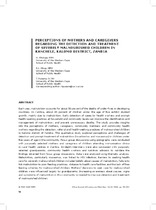| dc.contributor.author | Khunga, Helen | |
| dc.contributor.author | Puoane, Thandi | |
| dc.contributor.author | Okop, Kufre Joseph | |
| dc.date.accessioned | 2015-11-18T09:17:51Z | |
| dc.date.available | 2015-11-18T09:17:51Z | |
| dc.date.issued | 2014 | |
| dc.identifier.citation | Khunga, H., et al. (2014). Perception of mothers and caregivers regarding the detection and treatment of severely malnourished children in Kanchele, Kalomo district, Zambia. Africa Journal of Nursing and Midwifery, 16(2): 98–111 | en_US |
| dc.identifier.issn | 1682-5055 | |
| dc.identifier.uri | http://hdl.handle.net/10566/1977 | |
| dc.description.abstract | Each year, malnutrition accounts for about 50 percent of the deaths of under-fives in developing
countries. In Zambia, about 45 percent of children under the age of five exhibit stunted
growth, mainly due to malnutrition. Early detection of cases by health workers and prompt
health-seeking practices at household and community levels can improve the identification and
management of malnutrition, and prevent unnecessary deaths. The study provides insights
into the perceptions of mothers, caregivers, community members and community health
workers regarding the detection, referral and health-seeking practices of malnourished children
in Kalomo district of Zambia. This qualitative study explored perceptions and challenges of
detection and prompt treatment of malnutrition (kwashiorkor and marasmus) in children under
five years of age in the community. Focus group discussions using pictographs were conducted
with purposely selected mothers and caregivers of children attending immunisation clinics
in rural health centres in Zambia. In-depth interviews were also conducted with purposely
selected grandparents, community health workers and nutrition advisors to validate the
findings obtained from focus group discussions. Data were analysed using thematic analysis.
Malnutrition, particularly marasmus, was linked to HIV infection. Barriers to seeking health
care for severely malnourished children included beliefs about causes of malnutrition, failure to
link malnutrition to poor feeding practices, distance to health care facilities and the lack of free
feeding schemes for malnourished children. Mothers’ decisions to seek care for malnourished
children were influenced largely by grandparents. Increasing awareness about causes, signs and symptoms of malnutrition in this community is needed to improve detection and treatment
of malnourished children. | en_US |
| dc.language.iso | en | en_US |
| dc.publisher | Unisa press | en_US |
| dc.rights | This is the post print version of a published article which is available at http://upjournals.co.za/index.php/AJNM/article/view/27. | |
| dc.subject | Caregivers | en_US |
| dc.subject | Children | en_US |
| dc.subject | Community | en_US |
| dc.subject | Malnutrition | en_US |
| dc.subject | Treatment | en_US |
| dc.subject | Kanchele, Kalomo District, Zambia | en_US |
| dc.subject | Zambia | en_US |
| dc.subject | Kwashiorkor | en_US |
| dc.subject | Marasmus | en_US |
| dc.subject | HIV infection | en_US |
| dc.title | Perceptions of mothers and caregivers regarding the detection and treatment of severely malnourished children in Kanchele, Kalomo district, Zambia | en_US |
| dc.type | Article | en_US |
| dc.privacy.showsubmitter | FALSE | |
| dc.status.ispeerreviewed | TRUE | |
| dc.description.accreditation | Department of HE and Training approved list | en_US |

